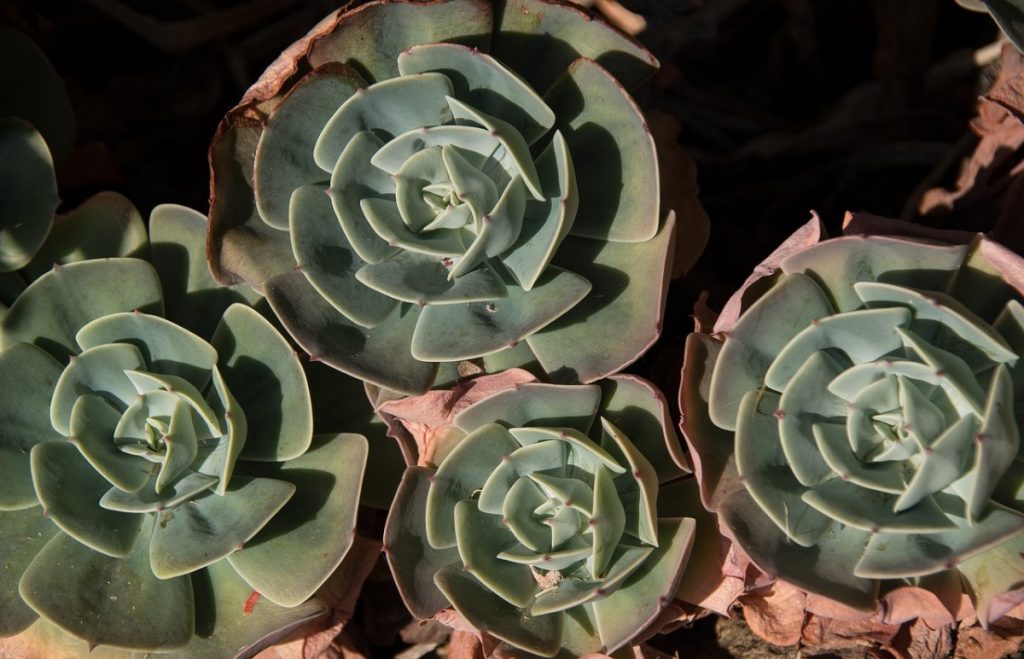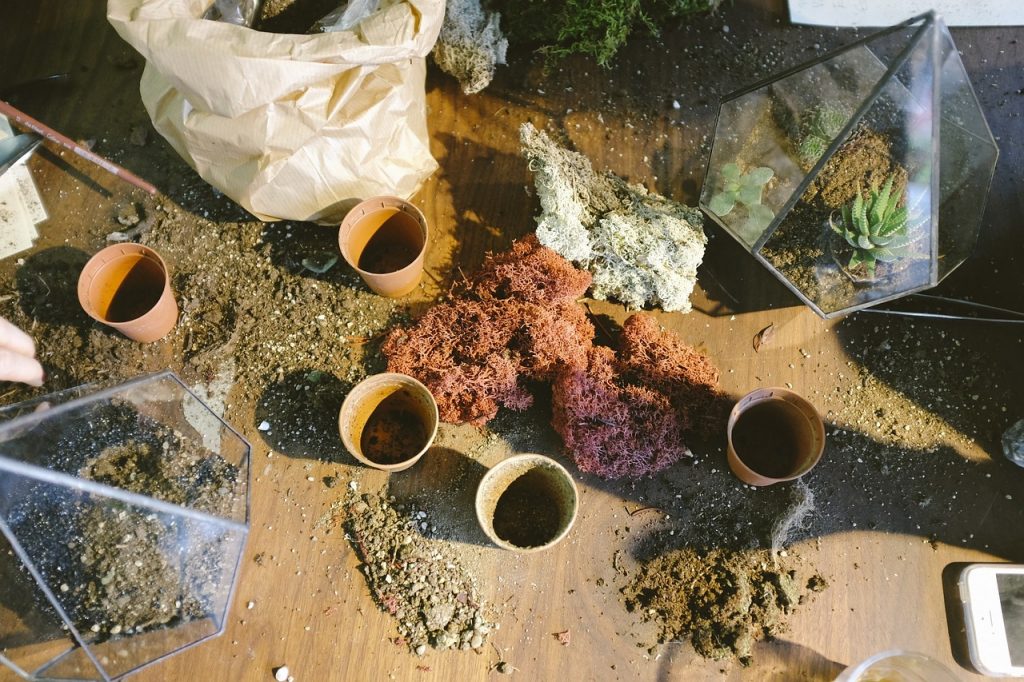Succulents are often regarded as resilient plants. Although they are, it does not mean that they do not suffer from any growth issues. If you see succulent leaves shriveling, it means that something wrong is going on. In reality we know two main causes of this phenomenon. It could be either under-watering or over- watering. The lack of water will lead succulent leaves to turn brown and shrivel. Too much water, on the other hand, could cause the leaves to shrivel, becoming soft and mushy in the process.
As you can see, both the lack and too much water are detrimental to succulent plants. The tricky part is determining which of the two might cause the problem. In this post, I will share with you the signs of under watering and over watering so you can identify the cause, and address it accordingly.
Table of Contents
How to tell whether my succulent got too much or too little water?
If you are a complete beginner to growing succulents (or plants in general), you can find it difficult to tel what’s going on. You simply follow your watering schedule, hoping for the best. But something is wrong, leaves start shriveling, and you do not know what to do. In such a case you will find the following list of symptoms handy:
Symptoms of Underwatered Succulents:
- Shrivel leaves
- Brown leaves
- The soil is completely dry
Symptoms of Overwatered Succulents:
- Leaves are turning yellow
- Leaves become translucent
- Soft and mushy leaves and stems
- The soil is wet
As you can see, the symptoms are similar, except for the soil and texture of the leaves. The best way to determine whether your succulent plant is under-watered or over-watered is to check the soil. Check the moisture in it. You can do this by sticking your finger into the soil and feel the moisture. If the dirt sticks to your finger when you take it back out to light,it is a clear indication that your soil is till wet. When your finger comes out clean, it tells you that the soil is already dry.
Another way to do this is by using a moisture meter (click here to check my recommended moisture meter on Amazon). This is, in my opinion, the most accurate way to determine the moisture in the soil. The weight of the pot can also tell you whether the soil is still moist or dry. What I like to do is to take the weight of a pot with completely dry soil and record it. Next time, I can easily determine whether the pot needs water or not by assessing its weight. A lighter pot means that the soil is already dry. Keep in mind though that as your plant grows, it gets heavier. You need to include it in your calculations…

Can You Save Underwatered Succulents with Shriveled Leaves?
The question of whether or not under-watered succulents can be saved depends on the severity of the problem. In most cases though, you can save your hardy fellas. As long as the succulent plant is not totally dead, it can recover. Remember that succulents are native to semi-desert areas. This means that they are used to experiencing dry periods with no rain.
When you notice this signs of under-watering, what you need to do is to give your succulent plants something to drink. Give them a good soak and let the soil dries before you water them again. If you do it right, succulent plants usually recover their normal appearance. Just maintain a good watering strategy–I recommend the soak and dry method.
Factors that influence the watering frequency
- The Growing Environment. The immediate environment where succulents are growing determines the water need of the plant. In an indoor environment, for instance, it takes a longer time for the soil to dry. Because you only water succulents when the soil is dry, the watering frequency is low. Frequent watering in this case can surely kill your plants, so be careful.
- Season or Climate. The other factor that affects the watering frequency of succulent plants is the season or climate. The soil moisture evaporates differently depending on the season. In summer, for instance, the soil moisture tends to dry pretty quickly. Thus, the watering is more frequent in summer than in winter. In colder seasons, the moisture takes time to dry thus succulent plants do need less frequent watering, often less than twice a month.
- Sunlight Exposure. The last factor that I can think of that affects the watering frequency is sunlight exposure. Needless to say, succulents in direct sunlight need more water than those in shade. Direct sunlight exposure evaporates the moisture in the soil making the plants thirsty.
Let me now share with you my three steps on successful succulent growing to avoid shriveling of their leaves.
1. Avoid light watering
I made this mistake when I started growing succulents. I thought that because succulents are accustomed to arid areas, they only need litter water. Hence I only watered them lightly. Sure enough, my succulents started to show some symptoms of under-watering. I noticed that the roots started to grow upward instead of downward and the entire root system was weak.
The leaves of the succulents also shriveled which alarmed me. I had no idea what was really going on. As you can see, light watering does not help the succulents plant at all. Although they are accustomed to dried areas, they love their roots being soaked in water occasionally–just like when a heavy rain pours down in a semi-desert area…
What you need to do is just soak the soil and let the excess water drains down to the drainage hole of the pot. Then water again once the soil is completely dry. However, before you soak the soil, make sure that you’re using an appropriate type of succulent soil.
2. Use a quick draining soil
I mentioned that soaking the soil when watering is what succulent plants need. However, you can only do this if you are using well-draining soil. If you are a complete beginner, make sure that you pick the gritty succulent mix. This type of soil does not absorb or retains too much water making the succulent roots safe from root rot. Also, an appropriate succulent soil mix provides aeration to the plant–something they truly love and are accustomed to from their natural habitat.
The good news is that such soil is easily available online (click here to check out my recommended succulent soil on Amazon). If you are willing and to make your own succulent soil though, you can also do it I have a complete guide on how to make succulent soil and grow succulents successfully. You can find it here.
If you decide to go on this route, make sure that you pick the right ingredients for your succulent soil. The ingredients should include both organic and inorganic materials. The final result should be soil that drains excess water fast and does not hold too much water for too long.

Can You Save Overwatered Succulents with Shriveled Leaves?
As I already mentioned, shriveling of leaves in succulent plants can be caused by over-watering. When the roots of succulent plants are soaked in too much water, the leaves will turn translucent or yellow. They will get mushy and soft. It can happen from several reasons, some of them are more obvious and some rather obscure–something you may not guess. Let’s have a look at them now.
1. Frequent watering
Watering succulents frequently more than they need can be tremendously dangerous to these hardy plants. Succulents store water in their stems and leaves which allows them to survive in drought. This characteristic, however, makes these plants vulnerable to diseases such as root rot and other health issues related to excess water. Avoid frequent watering and use the soak and dry technique instead.
2. Inappropriate soil
Garden soil is not appropriate for succulents. It holds too much moisture and does not drain water. As a result, the water in the soil can cause root rot. Use fast-draining soil instead to keep your succulent plants safe from these problems.
3. Saucers and trays
Many people use saucers and trays underneath the pot to collect water from the draining soil through the drainage hole of the pot. We see it commonly especially when growing succulents indoors, since it prevents the water from spilling. However, if the saucers or trays are not emptied, the water in them can potentially cause root rot and shriveling. So do not forget to empty the tray ten minutes after watering. If you do not do so, the roots can start rotting from the bottom of the pot, and before you know it the leaves start shriveling and you have a problem on the table.
4. High Humidity
High humidity triggers water stress which is not good for succulent plants. If you are growing succulents indoors, this is something you need to pay attention to. Do not place the plants near the bathroom because they do not like such humid places.
How to revive over- watered succulents with shriveled leaves
I learned the hard way that reviving an over-watered succulent is more tricky than reviving an under-watered plant. The success depends on the severity of the issue. If over-watering has already ruined the whole plant (or its rooting system), it will be impossible to revive it. However, if you spotted the shriveling early on, then you can definitely revive the plant. Here are the simple steps you can follow:
1. Reduce watering
The first step is completely logical: immediately reduce the amount of water. Do not water until the soil becomes completely dry. If the soil does not dry for days, it might be that the soil is not well-draining. In this case, you can change the soil and plant the succulent to a new pot.
2. Change the soil and repot the plant
A slow-draining soil will not serve the succulent plants well. It can only bring harm to your succulents. If this is the case, do not hesitate to change the soil. Replace it with fast-draining soil and repot the plant. This should help revive the succulent plants with shriveled leaves.
3. Choose safe locations for your succulents
A highly humid area in the house, for instance, is not good for succulent plants. It can only cause water stress. Bathrooms are examples of high humidity places that most succulents do not like. If you are growing succulents indoors, you need to take this into consideration.
The success in growing succulents depends on understanding the factors that have a direct effect on the growth of the plant. Watering is one of the factors that detrimentally cause growth issues in succulent plants if not implemented correctly. Keep it on your mind, and choose a fitting place for your beloved plants.
Final thoughts
The main reasons why succulent leaves shrivel are over-watering and under-watering. The best way to prevent over-watering is to use an appropriate watering technique. The one that I recommend is the soak and dry method. I hope this helps. If you want to learn more about growing succulents, you can check my complete guide here. Thank you!
